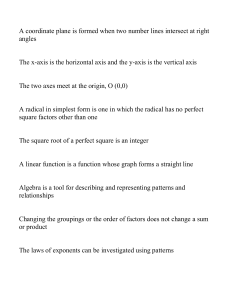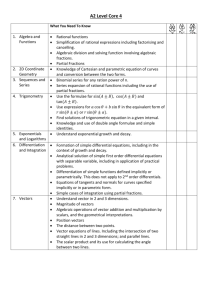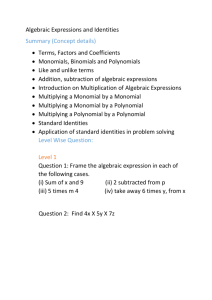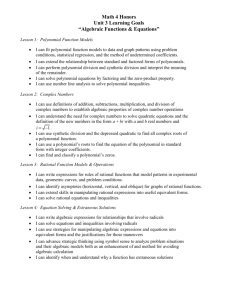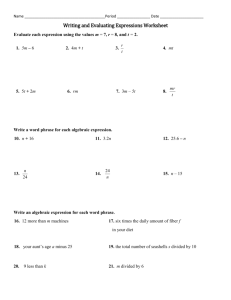Oct 31, 2007 Class Note Yingxin Chen The number grade on the
advertisement
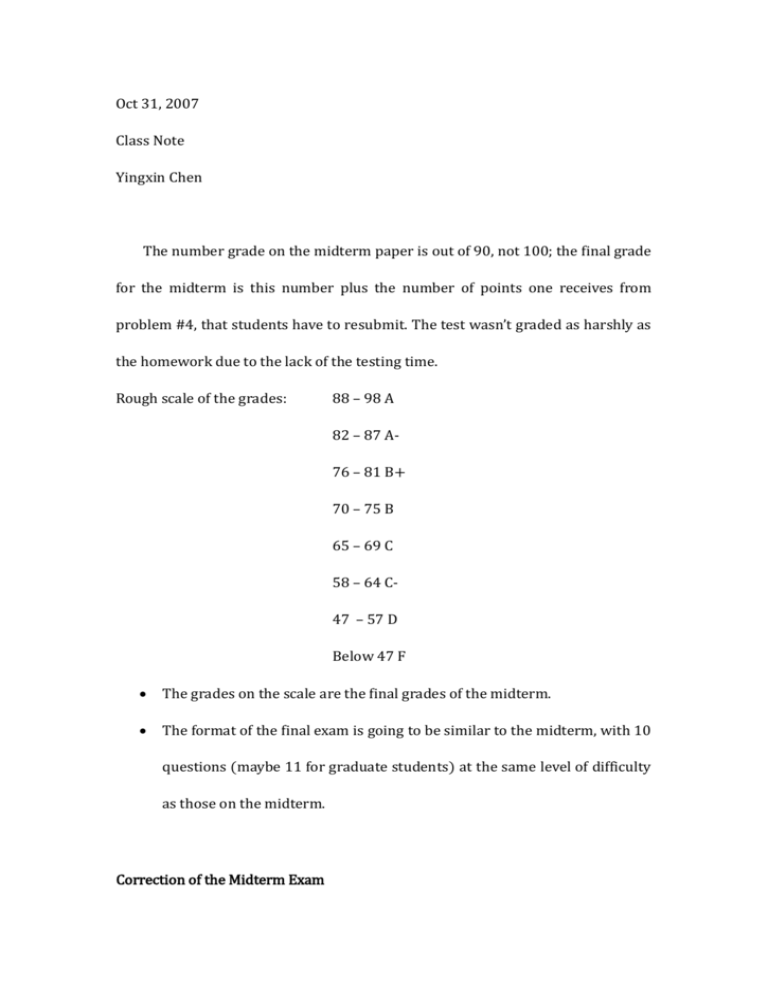
Oct 31, 2007
Class Note
Yingxin Chen
The number grade on the midterm paper is out of 90, not 100; the final grade
for the midterm is this number plus the number of points one receives from
problem #4, that students have to resubmit. The test wasn’t graded as harshly as
the homework due to the lack of the testing time.
Rough scale of the grades:
88 – 98 A
82 – 87 A76 – 81 B+
70 – 75 B
65 – 69 C
58 – 64 C47 – 57 D
Below 47 F
The grades on the scale are the final grades of the midterm.
The format of the final exam is going to be similar to the midterm, with 10
questions (maybe 11 for graduate students) at the same level of difficulty
as those on the midterm.
Correction of the Midterm Exam
#1 Let P(n) denote the statement:
1⋅1! + 2⋅2! + ⋯ + n⋅n! = (n+1)!
(a) Show that P(k) ⇒ P(k+1).
This is not an induction problem. All that is asked here is to show that P(k)
⇒P(k+1) is true, regardless the truth of P(k). Generally speaking, when p ⇒q, it
is possible to prove that q is true with p being false.
Here, P(k), or P(n), is the entire statement, not just the right hand side or the
left hand side of the equation.
Proof: Assume P(k) is true,
then 1⋅1! + 2⋅2! + ⋯ + k⋅k! + (k+1)⋅(k+1)!
= (k+1)! + (k+1)⋅(k+1)! since P(k) is true.
= (k+1)!⋅(1+(k+1))
= (k+2)⋅(k+1)!
= (k+1+1)!
Therefore, P(k+1) is true.
Therefore P(k) ⇒P(k+1).
The purpose of this problem is to understand the theory behind the
mathematical induction. The truth of the implication does not necessarily imply
the truth of the original statement.
(b) Is P(n) true for every natural number n?
The answer is no. We will show that it fails for some number n by giving an
example.
Consider the case when n=1:
1⋅1! =1
But (1+1)! =2! =2
1≠2
Hence P(1) is not true, therefore P(n) cannot be true for every natural number n.
#2 (a) Write a clear, concise definition of an algebraic number.
An algebraic number is a number that can be expressed as the root of a
nonzero polynomial with rational coefficients.
Examples: x2 – 4 = 0. We know that 2 and -2 are roots for this polynomial, hence
2 and -2 are algebraic.
x2 – 2 = 0. This polynomial may not have a root if we only consider
rational roots, but it does have roots in the real field. The roots are
√2 and -√2, and they are algebraic.
x2 – 1 = 0. This polynomial has roots in the complex field, which are i
and –i.
(b) Prove that the number √(1+√5) is algebraic.
Since we know that the root of a polynomial is a solution of that polynomial
equation, we set x =√(1+√5) to get a polynomial which has√(1+√5) as a
root. Or we can think of a polynomial that’s factored in to (x-√(1+√
5))⋅(
)⋅(
as a root.
), then x-√(1+√5) has to equal zero in order to have √(1+√5)
x -√(1+√5) = 0
x =√(1+√5)
x2 = 1+√5 →although this is a polynomial,
the coefficient is not rational,
i.e. √5 is an irrational
number.
x2 – 1 =√5
(x2 – 1)2 = 5
(x2 – 1)2 – 5 = 0
Define P(x)= (x2 – 1)2 – 5 = x4 – 2x2 – 4. Hence √(1+√5) is a root of P(x).
Therefore √(1 + √5) is algebraic.
OR
x2 = 1+√5
x4 = 1 +2√5 +5
x4 = 6 +2√5 *
2x2 = 2 + 2√5 **
Subtract ** from *; we will get x4 - 2x2 = 4
Hence P(x) = x4 - 2x2 – 4, and √(1+√5) is a root of the polynomial.
Therefore, √(1+√5) is algebraic.
#3 Recall from class that a function f from a group (G1, *) to the group (G2, ⋅) is
called a group homomorphism if, for every x and y in G1, we have f(x*y)=f(x)⋅f(y).
Consider the function defined by the equation f(x) = ax + b. Determine all
values of a and b for which this function defines a homomorphism from the real
numbers under addition to the real numbers under addition.
We want to find a, b so that f(x+y)=f(x)+f(y).
f(x+y) = a(x+y) + b = ax + ay + b
And
f(x) + f(y) = ax + b + ay + b = ax + ay + 2b
Hence, for f(x+y) = f(x) + f(y), we must have b=0.
OR
Set ax + ay + b = ax + ay + 2b, we will get that b = 2b, then b=0.
f(x+y)=f(x)+f(y) holds to be true regardless what value of a is, therefore a can be
any number inside the real numbers.
We are using addition here, because that’s what is asked to be used as the
operation.
Hint for #4
Students should give a function as the example, not an equation. Also,
students are not allowed to use the exponential function for part b, since the
example on #4 is one of that kind.
#5 Consider the operation of taking powers on the natural numbers. The
operation is defined a*b = ab.
(a) Is this operation commutative? Either prove that the operation is
commutative or provide a counter-example.
Is a*b = b*a?
No, this operation is not commutative.
Take a = 2 and b = 3, then a*b = 23 = 8, and b*a = 32 = 9, 8≠9.
Therefore, a*b≠b*a.
(b) Is this operation associative? Either prove that the operation is associative or
provide a counter-example.
Is a*(b*c) = (a*b)*c?
a*(b*c) = a*(bc) = ab^c
(a*b)*c = (ab)*c = (ab)c = abc
No, this operation is not associative.
Take a = 2, b = 3, and c = 2.
a*(b*c) = 2 *(32) = 23^2 = 29
(a*b)*c = (23)*2 =(23)2 =26
and 29 ≠ 26. Therefore a*(b*c) ≠ (a*b)*c.
#6 (a) Consider the relation on the set of angles given by
α ~ β ⇔ sin α = sin β (or ⇔ cos α = cos β for the other version). Prove
that this is an equivalence relation.
We need to check that the three properties have to be satisfied, which are the
reflexive property, the symmetric property, and the transitive property.
Reflexive property: Since sin α = sin α, we have α ~ α.
Symmetric property: If sin α = sin β, then sin β = sin α by the symmetry of
the “=” sign. Hence α ~ β, ⇒ β ~ α.
Transitive property: Suppose α ~ β, and β ~ λ , then sin α = sin β, and sin
β = sin λ. By transitivity of “=”, sin α = sin λ, hence α ~ λ.
Therefore, α ~ β ⇔ sin α = sin β is an equivalence relation. (The proof for the ⇔
cos α = cos β is very similar to this one.)
(b) Describe the equivalence class of angles equivalent to θ = 42° .
The equivalence class for the sine function of θ=42° is {42°+360°n} and
{138°+360°n}.
The equivalence class for the cosine function of θ=42° is {42°+360°n} and
{-42°+ 360°n}.
(c) Suppose that we want to restrict the domain of the cosine function to include
exactly one representative from each equivalence class. Which angles θ
should we include in the domain?
We can see that in the figure above, the values inside the yellow region hit the
entire domain, which is the interval from -1 to 1. Therefore, if we restrict θ to be
from π/2 or 90° ≤θ ≤3π/2 or 270° , sine of any angle in this interval will hit
points between 1 and -1.
As we can see from the figure above, the values in the orange region map the
entire domain of the function, which is -1 to 1. Thus, for the cosine function we
can restrict θ to be from 0 or 0°≤θ ≤π or 180°. Cosine of any angle in this
interval will hit any point between 1 and -1.
We use ≤ sign because we want to include 1 and -1 to be in the range.
#7 Clearly indicate whether each statement is true or false. You need not prove
your answer in this section.
(a)
T
All rational numbers are algebraic.
Take any number a∈Q, we can construct a polynomial p(x) = x – a,
therefore a is algebraic.
(b)
F
All irrational numbers are algebraic.
This is false. Consider π and e, irrational, but not algebraic.
(c)
T
Some integers have multiplicative inverses.
This is a “some” statement which can be proved to be true by giving
examples. The integers, 1 and -1 have multiplicative inverses, namely, 1
and -1.
(d)
T
Some rational numbers have multiplicative inverses.
All non-zero rational numbers have multiplicative inverses.
(e)
F
All real numbers have multiplicative inverses.
Consider 0∈R, 0 doesn’t have multiplicative inverse.
(f)
F
The relation ≤ on the set of real numbers is an equivalence
relation.
≤ is not an equivalence relation because it fails to satisfy the symmetric
property. Consider: 4≤5 , but 5≤4.
(g)
F
All algebraic numbers are irrational.
Previously, we have shown that 2 is an algebraic number, and 2 is rational.
(h)
F
All algebraic numbers are rational.
Previously, we have shown that √2 is an algebraic number, and √2 is
irrational.
(i)
F
Irrational numbers are not complex.
Irrational numbers live inside R, which live inside C, therefore irrational
numbers are complex.
(j)
F
Complex numbers are all of the numbers that are not real.
Real numbers live inside the complex number, which means the complex
numbers include the real numbers.
#9 Let F denote an ordered field. That is, F is a set, closed under two operations,
+ and ⋅, satisfying the field axioms stated in class, with a relation <, that satisfies
the following properties:
(a) For every x and y in F, exactly one of the following is true: x < y, y < x, or x
= y.
(b) The relation is transitive: x < y and y < z imply that x < z.
(c) x < y implies that x + z < y + z.
(d) x < y and 0 < z implies xz < yz.
Let x be an element of an ordered field. Prove that either x = 0 or 0 < x2.
The best way to prove an “or” statement is to assume one of the
conditions is not true, and then prove the other one has to be true. In
other words, to prove p V q, it is enough to show that ~p⇒q.
Proof:
Assume x≠0, want to show 0<x2.
Case I: 0 < x
Since 0< x, we can multiply by x on both sides,
0⋅x < x⋅x
0< x2
Case II: x <0
We can’t multiply x on both sides here because x is not > 0.
Instead, we add –x to both side.
-x + x < -x + 0
0< -x
We then multiply –x on both sides, we get:
0⋅-x < -x⋅-x
0 < x2
Therefore, if x is an element of an ordered field, either x = 0 or 0 < x2 is true.
#10
Most students got this question correct. However, some students have
assumed the variable x denotes an object, like an apple or a box, but x really
denotes the number, or the amount, i.e. the number of apples, or the number of
boxes.
Another thing we have to be careful about is that if we would write a false
statement on a paper, it is better not to write anything at all. For instance, we
know that 5≠3, so do not write 5 = 3.
Regents Exam:
The test will be held on Nov 20th, Tue, from 5:20pm to 7:20 pm; those who can’t
make it should contact Prof. Berger to arrange an appropriate time.
Review sessions for the Regents exam will be held on Wed, 14th, from 12: 50pm
to 2: 10pm, and on Nov 8th or 9th.
